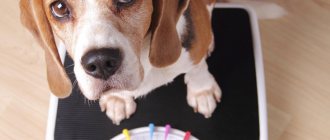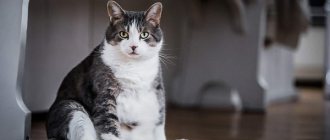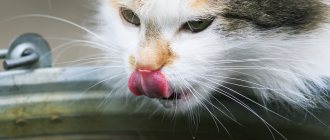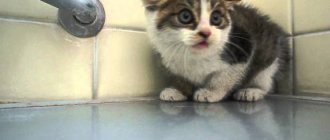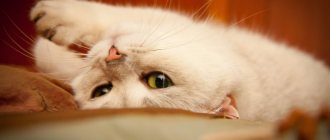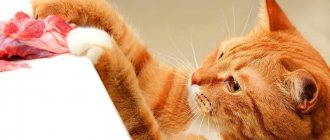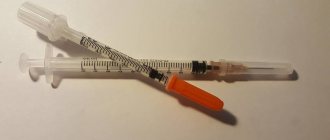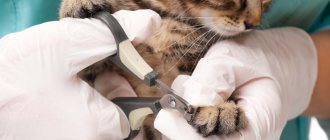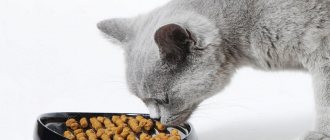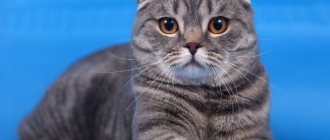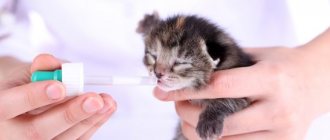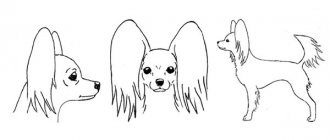To help your pet get rid of obesity, it is important to understand the reason for its development. Sometimes excess weight appears due to illness, and not due to excessive appetite. Methods of losing weight are selected strictly individually and depend on the physiological characteristics of the pet.
However, the veterinarian’s recommendations are always the same. The specialist prescribes the fat man to exercise a lot and eat right. The cat will not be able to follow these recommendations on its own, so the responsibility for maintaining a healthy lifestyle for the pet falls on the shoulders of the person. Not only its appearance, but also its life expectancy depends on this.
Why does my cat need to lose weight?
A single kilogram of excess weight already increases the risk of your pet developing serious diseases. Unfortunately, if your cat is overweight or obese, it is no longer a question of whether she will develop complications and illnesses associated with it, but when exactly they will appear and how serious they will be. Most often, excess weight is accompanied by:
- Type II diabetes – it is three times more common in obese cats than in animals of normal weight;
- Heart diseases;
- Increased risk of joint injuries;
- Osteoarthrosis (arthritis);
- High pressure;
- Some forms of cancer, especially tumors in the abdominal cavity.
Overweight and obese animals tend to live shorter lives than their slender counterparts. If a cat is overweight, it moves less and becomes less energetic and playful. The purr prefers to just lie down, and because of this it is easy to miss the first signs of illness, mistaking lethargy for “normal laziness.”
Now we are just beginning to understand the danger that extra pounds can pose to both humans and their four-legged friends.
All about obesity in cats
From the very first days of a cat's appearance in the house, the owner must provide his pet with the right diet and sufficient physical activity. Controlling the amount of food consumed is an important task, because extra pounds significantly shorten the life of a mustache.
Why does an animal become overweight?
A cat becomes fat when it eats more food than it needs. Thus, the fluffy one consumes a lot of extra calories, which it cannot expend within the apartment. During adolescence, when children and teenagers are very active and play a lot, overeating does not affect appearance. However, over the years, excessive appetite leads to an increase in body fat and ultimately to obesity.
An excellent appetite is not always the reason for weight gain. Some disorders in the body lead to the accumulation of extra pounds. Typically this is:
- diabetes mellitus type II;
- metabolic disorders;
- diseases of the cardiovascular system;
- arthrosis and arthritis;
- oncological diseases;
- high blood pressure;
- disruptions in the hormonal system;
- castration or sterilization operations performed at a late age;
- incorrectly selected diet;
- disorders in the gastrointestinal tract.
Wild and even domestic felines rarely suffer from excess weight, so they get sick less often. Domestic individuals usually lead a sedentary lifestyle, and obtain food without making any effort. A sedentary lifestyle can hardly be called healthy, which is why most fat people suffer from various ailments.
Why is obesity dangerous?
Veterinarians report that more than a third of all pet whiskers suffer from excess weight. Cats get too carried away with tasty treats and begin to gain extra pounds. The consequences of this can be dire because they provoke the development of serious health problems. The most common of them are:
- joint diseases;
- liver problems;
- pathologies of the cardiovascular system;
- high blood pressure;
- dangerous neoplasms;
- diabetes.
Excessive weight prevents your pet from leading an active lifestyle, running with other animals, and playing. The fat guy doesn’t want to get up from the couch, and even small physical activity causes him shortness of breath and discomfort. All this negatively affects the physical condition of the pet and leads to a shortening of its life.
How to determine if your pet's weight is outside the normal range
On average, the weight of an adult varies from 3 to 6 kg. Males are usually 1-2 kilograms heavier than females of the same breed.
In general, weight gain is influenced by various factors. The main ones include gender and breed, type of feeding, heredity, and general physical condition. For example, the normal weight of large species can reach 8-10 kg. This is considered the norm.
Signs that your pet is overeating should be cause for concern. His stomach begins to sag and his waist disappears. If you pick up the animal, you can easily feel the fat layer. But the ribs, pelvic bones and spine, on the contrary, cannot be found by touch.
Obesity changes the appearance of the mustache and leaves it with a lot of inconvenience. The fat man's gait changes, he begins to waddle and loses his former grace.
Where to begin?
In theory, it's simple: consume fewer calories, burn more, and this will lead to weight loss. Unfortunately, in reality everything is somewhat more complicated. Never put your cat on a diet without consulting your veterinarian.
Physiologically, cats are different from humans and dogs, and a two-day fast can lead to the development of a fatal disease known as hepatic lipidosis (or fatty liver disease). Your cat should first be seen by a veterinarian, who may order additional tests to make sure there are no underlying medical conditions or other barriers to weight loss. If everything is fine, you can already think about how to help your cat lose weight.
Reasons for the need to lose weight
The reasons why an overly plump cat needs to lose weight are associated with the harm that excess weight causes to the animal’s body. Due to the abundance of fat, the following occurs:
- deterioration of the functions of internal organs, primarily the liver, heart, blood vessels;
- the occurrence of type 2 diabetes;
- problems with movement, muscle atrophy;
- deformation of joints under the influence of excessive load, development of arthritis and arthrosis;
- lack of oxygen due to heart failure.
Obesity can provoke the development of cancer. All these factors dramatically reduce the time and quality of life of a pet. And communication with the owner comes down to petting: the cat has no desire to play, becomes sleepy, lethargic, and its hunting instincts fade. In a private home, this can lead to the appearance and reproduction of rodents.
Excess weight prevents the animal from moving normally
How to feed a cat to make it lose weight?
To answer this question, your veterinarian will need to examine your cat and, based on her body type and size, determine what weight would be ideal for her. Specially developed formulas and graphs will help him with this, thanks to which he can also calculate the cat’s calorie needs per day in order to achieve the desired weight without harm to health.
On average, an adult domestic cat should weigh 3.6 – 4.4 kg. Depending on the degree of obesity, your doctor may recommend first achieving an intermediate weight, which is slightly larger than your ideal weight. For example, if your cat weighs around 8kg, her ideal weight would be 4.4 – 5.5kg, but a more realistic target would be an intermediate weight of 6.8kg. Once it has been achieved, it is necessary to re-evaluate the pet’s condition and determine whether the cat should lose weight further.
How to calculate your cat's calorie needs
The weight loss formula for cats is based on the cat's resting energy requirement (the number of calories a cat needs when not physically active, or PEED), which is calculated as follows:
- Method: PEPP in kcal/day = 70 x (ideal weight in kg) x by ¾;
- Method: PEPP in kcal/day = 30 x (total weight in kilograms) + 70.
To lose weight, a cat must receive 80% of the PEPP (multiply the PEPP by 0.8). In order not to waste time on calculations, you can use the table:
| Ideal Weight: lbs (kg) | Calories that make up 80% of your daily nutritional intake |
| 8 (3,6) | 180 |
| 10 (4,5) | 210 |
| 12 (5,4) | 230 |
Please note: These are general guidelines and cannot replace the advice of your veterinarian. If your cat is unable to lose weight by consuming the specified amount of calories, it should be reduced.
Diet for pancreatitis
The disease pancreatitis in cats increases carbohydrates and fats, so the diet should help reduce them. The diet will help increase good protein in the body. The cat should only be given foods that are quickly digestible. The diet consists of 3–5 feedings a day in small portions. The food temperature should be slightly above room temperature . The products are ground, cut into small slices, and prepared into purees and soufflés.
Food in the form of broths, all types of soups, meat, fish, vegetables, herbs and fruits are not given. If the disease has worsened, the pet is not fed at all for some time, and fasting days are carried out for 1-2 days.
The food composition of the menu includes the following products:
- Chicken soups, always with 2-3 broth.
- Not fatty veal, chicken, lamb, rabbit.
- Not oily fish, boiled or steamed.
- Carrot puree, zucchini, beet, pumpkin.
- Chop.
- Milk, cottage cheese and eggs.
- Vegetable oil.
Which food to choose?
Since cats are obligate carnivores, human diets are not suitable for them. A diet high in protein and low in carbohydrates should help your cat lose weight. This is exactly the food you need to choose.
The amount of food needed to provide the required amount of calories depends on its calorie content. Usually the calorie content of the food is indicated on the packaging, and a specialist will explain to you what portions it should be given.
Usually, a cat loses weight most effectively by receiving dietary canned or dry food several times a day. You can’t leave it in a bowl while losing weight, because regular meals are healthier than constant snacking throughout the day. How to make a cat lose weight if it always has the opportunity to crunch on something out of boredom or for pleasure?
It is very important to learn how to count calories and measure the prescribed amount of food. If there is too much food, the animal will not lose weight, and if there is too little, it will begin to starve, which, as already mentioned, is very dangerous for cats.
Start working!
lacarmina.com
You can't do without exercise and, of course, you won't be able to get your cat on a treadmill. Start small: buy a scratching post and explain how to use it.
This may seem like a small thing, but it's not. For a lazy cat, accustomed to lounging between the sofa, bowl and litter box, any activity will be important.
How long does it take to train a cat to go on a diet?
Give your cat a week or two to get used to the new diet. First, mix ¼ of the new food with ¾ of the usual food for 2 to 4 days. Then increase the amount of new food to half, and in the last 3 to 5 days before the final transition to the new diet - to ¾.
To improve palatability, you can heat the food and add flavoring additives, for example, based on fish oil containing Omega-3 fatty acids.
If your cat refuses a new diet, or if you have any questions while introducing her to a new food, do not hesitate to contact your veterinarian for advice.
How to get your cat to move more?
In an ideal world, you could go for a morning run with her, but unfortunately, we don't live in an ideal world. Making a cat lose weight by exercising with it is not just difficult - it goes against the very nature of this animal.
Sprinters, not marathon runners
Cats are not adapted to the lifestyle of scavengers or pack hunters, like humans and dogs. They are ambush predators that expend very little energy searching for prey and rarely venture beyond their territory. Having discovered prey, the cat launches into a very intense and short chase.
Most wild cats chase prey at top speed for no more than a minute. When the chase is over, the cat requires many hours of recovery for the next hunt.
Domestic cats are smaller versions of wild cats. We can take our dog with us for a walk or jog, but among cats there are only a few who love active recreation. Cats prefer short distances rather than marathons. You will have to call on all your ingenuity to help make the mustachioed hulks move more.
Useful ideas
Place the food bowl in different places, such as at the top or bottom of the stairs, and try to place it so that the cat has to travel a certain distance before reaching the food. Cats are smart: having realized that the bowl is now at the top, they themselves will go upstairs more often.
Place the food bowl as far as possible from the cat's preferred areas. Many obese cats sleep and rest near a bowl so they don't have to walk far to get food.
Buy food container toys - they are usually shaped like a ball that the cat rolls to get the treat. You need to put a certain amount of dry food inside these interactive toys, and the cat will have to work hard to get it.
Take time to play with your cat, use feather teasers, laser pointers, paper or foil balls - anything that your cat will be interested in catching. Try playing with your cat for ten minutes twice a day. This can be done while eating, watching TV or even reading.
There are many moving and squeaking toys that may interest your cat. Cats love variety, and a toy that the animal liked today may become boring tomorrow.
Physical activity
A cat cannot be forced to lose weight like a dog through jogging and sports exercises. Therefore, the owner has to invent different ways to increase the physical activity of an animal with extra pounds.
How to make a cat move?
Regular physical activity will help reduce fat accumulation in your home couch potato. It’s good if they have the opportunity to go outside - in this case it will be easier to get rid of excess weight. You can purchase a special harness and go for walks with your cat.
It wouldn’t hurt to tease your baby, encouraging him to run after a ball or his favorite toy. It is convenient to use special weight-loss feeders with grooves for feeding - they will force the fluffy to work hard before eating the yummy food. You can make your own bowl suitable for these purposes by cutting out a window in a plastic bottle. The couch potato will roll it around to get to the food.
“Exercises” for mustaches
Experienced cat owners have long known how to lose weight for a castrated cat at home. They recommend placing food bowls in places where the animal can only get through small barriers. For example, you can raise the plate higher on the platform or place an obstacle in front of it that needs to be climbed or overcome. For example, you can place a bowl of food on the top step of the stairs.
It will be useful to purchase/make a running wheel or special slides. Your four-legged friend will train on them, gradually losing extra pounds.
The simplest and most accessible “exercise” for a mustache is to connect the front and rear legs together and spread them apart - this exercise is performed by the hands of the owner.
What not to do
Cats cannot live the same way as dogs or people. Representatives of the cat family are predators that prefer to sit in ambush and wait. Because of this, they spend a small amount of energy and rarely leave the territory.
An animal should not be forced to run at maximum speed for more than one minute. The pet does not recover well after long distances, and this can harm the health of the furry. It is better to drive it little by little, but often.
How often should you re-weigh?
Once you have developed a plan for how to lose weight for a cat in such and such a time, with your help, it is very important to understand whether it is effective.
Each cat is unique, and the recommended diet may require several adjustments before you see results. On average, a cat should be weighed every month until it reaches its ideal weight. If there is no result within a month (weight loss of about half a kilo), the program needs to be adjusted. Sometimes even a small change is enough.
What to do if your cat is constantly begging for food?
When cats wake us up at four in the morning, demanding food, screaming like crazy, or non-stop poking their foreheads at their owner, we give up. The cats have trained us well, they know very well which buttons to press to get what they want! Here are some tips for pacifying annoying Persians or irrepressible Siamese:
- Do not use automatic feeders. It is quite obvious that the automatic feeder for the fat tailed man is a machine filled to the brim with candies.
- Pet your cat or play with her when she begs for food. Many cats perceive food as equivalent to their owner's attention, and you may find over time that play replaces the cat's meal.
- Feed your animal in smaller portions, but more often, so you can provide a late dinner for a cat who likes to wake you up in the morning. Divide your total calories into four to six small portions. The most important thing is not to give your cat food in excess of the prescribed amount.
- If the bowl is empty and the cat won't calm down, put a couple of pieces of food in the bowl. A couple of pieces, not a handful.
- Offer your cat fresh water instead of food. When your cat is persistently staring at an empty bowl, a sip of fresh, cold water can curb her appetite.
How to feed other cats if only one needs to lose weight?
You may find a better solution to the problem, but here are some tips to get you started:
- Feeding cats separately is the ideal solution for such cases. Give your losing cat some diet food in one room and feed the rest in another. When the time allotted for a meal is over - usually from fifteen minutes to half an hour - remove what the animals did not eat until the next feeding.
- Feed a cat that is not overweight at the top, where it is more difficult for an overweight cat to climb.
- Never leave food out in the open unattended. This way you won’t be able to control who eats what and when!
Tricks and life hacks
During the process of losing weight, it is difficult not only for a well-fed friend, but also for the owner himself and his family members. The animal's mood changes, it often gets irritated, behaves aggressively, and persistently asks for food. Advice from experienced owners will help you get through this difficult period.
Healthy treats
Feeding a friend prone to obesity from the host's table is strictly contraindicated. As healthy treats, you can offer sticks specially made for this purpose; they are made from low-fat meat products - such straws are sold in any pet store.
Pieces of chicken or fish are also suitable for encouragement. But you shouldn’t pamper your fluffy often – this can ruin his appetite and lead to gluttony.
Weaning off begging
Begging for food, the cat looks pitifully at the person. But the owner and family members should not succumb to provocations. Feeding will not be a manifestation of care and love for your mustachioed friend.
The animal should be weaned from begging. The best way to do this is to distract his attention. You can talk to your pet, pet him or offer him a toy. If he doesn't calm down, you should pour him fresh water.
What to do if there are several animals
If there are several pets in the house, and only one needs to lose weight, then difficulties arise. The main way to provide a fat baby with dietary nutrition and prevent him from eating from other bowls is separate feeding. Food should be placed in different rooms or a bowl of thin pets should be placed on the upper steps, where it is more difficult for a well-fed companion to reach. The main thing is not to leave plates of food unattended.
How long will my cat have to be on the diet?
Most cats reach their ideal weight within 6 to 8 months. If the process is delayed, then something needs to be changed. Healthy weight loss is about a pound per month. Some cats take longer, while others lose weight faster.
For most cats, the secret to effective weight loss is attentive and responsible owners. Cats don't understand that obesity is killing them. We, as good owners, must protect them from danger and, of course, not unwittingly contribute to their development of serious illnesses or their premature death.
Only by working closely with your veterinarian and your entire family can you ensure that your cat remains fit and healthy.
The recommendations are based on the work of veterinarian Ernest Ward.
